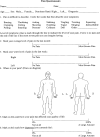Social impact of peripheral nerve injuries
- PMID: 26034424
- PMCID: PMC4447662
- DOI: 10.1007/s11552-014-9692-0
Social impact of peripheral nerve injuries
Abstract
Background: Disorders involving the peripheral nervous system can have devastating impacts on patients' daily functions and routines. There is a lack of consideration of the impact of injury on social/emotional well-being and function.
Methods: We performed a retrospective database and chart review of adult patients presenting between 2010 and 2012 with peripheral nerve compression, brachial plexus injury, thoracic outlet syndrome (TOS), or neuromas. At the initial assessment, patients completed a questionnaire used to obtain demographic and psychosocial variable data including the (1) average level of pain over the last month, (2) self-perceived depression, (3) how much pain impacts quality of life (QoL), (4) current level of stress, and (5) ability to cope with stress. Statistical analyses were used to assess the differences between the dependent variables and diagnostic and demographic groups.
Results: This study included 490 patients (mean age 50 ± 15 years); the most common diagnosis was single nerve compression (n = 171). Impact on QoL was significantly greater in patients with TOS, cutaneous peroneal compressions, and neuroma versus single site nerve compressions. Average pain, impact on QoL, and stress at home were significantly higher in females versus males. Impact on QoL was correlated with average pain, depression, stress at home, and ability to cope with stress at home.
Conclusions: Our study demonstrates that patients with single site nerve compression neuropathies experience fewer negative psychosocial effects compared to patients with more proximal upper extremity peripheral nerve disorders and neuromas. The impact on QoL was strongly correlated with pain and depression, where patients with neuromas and painful peroneal nerve entrapments reported greater detriments to QoL.
Keywords: Injury; Peripheral nerve; Psychosocial; Upper extremity.
Figures


References
LinkOut - more resources
Full Text Sources
Other Literature Sources
Medical

